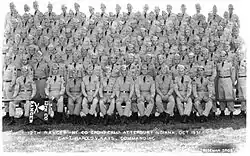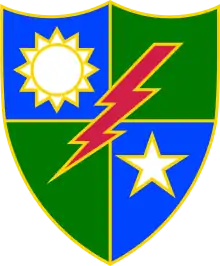Korean War Ranger Companies
The Korean War Ranger Companies were the United States Army Rangers of the Korean War.
History

At the outbreak of war in Korea, a unique Ranger unit was formed. Headed by Second Lieutenant Ralph Puckett, the Eighth Army Ranger Company was created in August 1950.[1] It would serve as the role model for the rest of the Ranger units to be formed. Instead of being organized into self-contained battalions, the Ranger units of the Korean and Vietnam eras would be organized into companies and then attached to larger units, to serve as organic special operations units.
In addition to the special skills and techniques used by their forebears, the Ranger Infantry Companies added airborne assault to their repertoire. All Rangers within the companies were airborne qualified.[2]
In total, eighteen additional Ranger companies were formed in the next seven months: Eighth Army Raider Company and First through Fifteenth Ranger Infantry Companies (Airborne) and Ranger Infantry Companies A & B.[3] The Army Chief of Staff assigned the Ranger training program at Fort Benning to Colonel John Gibson Van Houten.[4] The program would eventually be split to include a training program located in Korea. 3rd and 7th Ranger companies were tasked to train new Rangers.
The 28 October 1950 would see the next four Ranger companies formed. Soldiers from the 505th Airborne Infantry Regiment [5] and the 82nd Airborne's 80th Anti-Aircraft Artillery Battalion volunteered and, after initially being designated the 4th Ranger Company, became the 2nd Ranger Company — the only all-black Ranger unit in United States history. After the four companies had begun their training, they were joined by the 5th-8th Ranger companies on 20 November 1950.
During the course of the war, the Rangers patrolled and probed, scouted and destroyed, attacked and ambushed the Communist Chinese and Korean enemy. The 1st Rangers destroyed the 12th North Korean Division headquarters in a daring night raid. The 2nd and 4th Rangers made a combat airborne assault near Munsan where Life Magazine reported that Allied troops were now patrolling north of the 38th Parallel. Crucially, the 2nd Rangers plugged the gap made by the retreating Allied forces, the 5th Rangers helped stop the Chinese 5th Phase Offensive. To provide manning slots for newly activated Special Forces units, all Ranger companies were inactivated in 1951, beginning with the Eighth Army Ranger Company on 28 March and ending with 6th Ranger Company on 1 December.
Organization
| Company | Unit Attached | Date Activated | Date Inactivated |
|---|---|---|---|
| Eighth Army Ranger Company (8213 AU) | 25th Infantry Division / IX US Army Corps | Aug, 25 1950 | Mar, 28 1951 |
| GHQ Raider Company (8227 AU) / X Corps Raider Company (8245 AU) | Special Activities Group / X US Army Corps | Nov, 12 1950 | Apr, 1 1951 |
| 1st Ranger Company | 2nd Infantry Division | Oct, 28 1950 | Aug, 1 1951 |
| 2nd Ranger Company | 7th Infantry Division / 187th ABN. RCT | Oct, 28 1950 | Aug, 1 1951 |
| 3rd Ranger Company | Ranger Training Command / 3rd Infantry Division / I US Army Corps | Oct, 28 1950 | Aug, 1 1951 |
| 4th Ranger Company | 1st Cavalry Division / 187th ABN. RCT / 1st Marine Division | Oct, 28 1950 | Aug, 1 1951 |
| 5th Ranger Company | 25th Infantry Division / I US Army Corps | Nov, 20 1950 | Aug, 1 1951 |
| 6th Ranger Company | Seventh US Army | Nov, 20 1950 | Dec, 1 1951 |
| 7th Ranger Company | Ranger Training Command | Nov, 20 1950 | Nov, 5 1951 |
| 8th Ranger Company | 24th Infantry Division / IX US Army Corps | Nov, 20 1950 | Aug, 1 1951 |
| 9th Ranger Company | Third US Army | Jan, 5 1951 | Nov, 5 1951 |
| 10th Ranger Company | 45th Infantry Division | Jan, 5 1951 | Oct, 15 1951 |
| 11th Ranger Company | 40th Infantry Division | Jan, 5 1951 | Sept, 21 1951 |
| 12th Ranger Company | 28th Division | Feb, 1 1951 | Oct, 27 1951 |
| 13th Ranger Company | 43rd Infantry Division (United States) | Feb, 1 1951 | Oct, 15 1951 |
| 14th Ranger Company | 4th Infantry Division | Feb, 27 1951 | Oct, 27 1951 |
| 15th Ranger Company | Third US Army | Feb, 27 1951 | Nov, 5 1951 |
| Ranger Infantry Company Able "A" | Ranger Training Command | ||
| Ranger Infantry Company Baker "B" | Ranger Training Command |
References
- National Infantry Foundation biography of Ralph Puckett Archived 27 September 2007 at the Wayback Machine
- A Brief History of the American Rangers (1634 – present), Larry E. Ivers Archived 28 September 2007 at the Wayback Machine p.5
- "modernrangers". Archived from the original on 4 February 2005. Retrieved 27 August 2012.
- Lock, John D. and Moore, Harold G. To Fight With Intrepidity: The Complete History of the U.S. Army Rangers 1622 to Present Fenestra Books, 2001 ISBN 1-58736-064-0 p.286
- During the late 1940s the separate, all-black 555th Parachute Infantry Battalion was merged into the 505th AIR to become the regiment's "new" 3rd Battalion.
- "modern rangers". Archived from the original on 4 February 2005. Retrieved 27 August 2012.
- Lock, John D. and Moore, Harold G. To Fight With Intrepidity: The Complete History of the U.S. Army Rangers 1622 to Present Fenestra Books, 2001 ISBN 1-58736-064-0 pp. 513-514
- Bahmanyar, Mir (2005). Shadow Warriors: A History of the US Army Rangers. Osprey Publishing. p. 339. ISBN 9781841768601.
